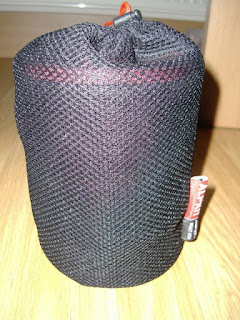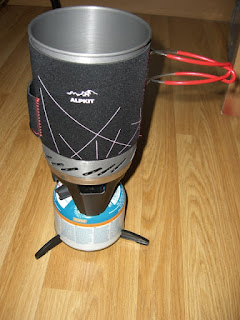For reasons I won't go into, I didn't end up with a free Jetboil, and my argument for getting a gas stove wasn't strong enough to warrant shelling out for one, so I had a look at what else was out there. One stove in particular stood out a mile, not least because it was half the price of its nearest rival. That stove was the Alpkit BruKit.
I'm sure Alpkit won't mind me saying that their BruKit is really a re-badged Fire Maple stove- no bad thing, considering that the original version could cost you twice as much.
In a similar vein to other such stoves offered by Jetboil, Primus and MSR, the BruKit combines a pot and heat exchanger plus burner, and the pot is large enough to hold the burner and (supposedly- see below) the gas canister when packed away. Also included is a neoprene "pot cosy", lid, and a nice mesh bag to pack it all away in. Some people have commented that they struggled to get the stove back in the bag, but I didn't find this a problem at all.
The pot locks into the burner easily but firmly, and all the components appear well made.
The pot itself is fairly large at 1.3 litres (Alpkit state variably that the pot is 1 litre and 1.2 litres. I got the measuring jug out and it'll take 1.3 litres with room to spare), and anyone used to the 1 litre pans of a Trangia 27 won't know what to do with all the extra space. Personally I could have made do with a much smaller pot- 1 litre max- but this is obviously subjective depending on how you plan to use the stove. It also needs to be this big to fit the burner and gas into when packing away.
Testing the BruKit indoors, the piezo ignited the gas first time, and I soon had 750ml of water on the boil. I didn't bother timing how long this took; if boil times are important to you there are plenty of documented tests of this on the internet, but generally I'm in no rush when I'm out in the hills.
Once your water has boiled, removing the pot from the burner has a knack to it- while the neoprene cosy allows you to grab the pot without getting first-degree burns, it doesn't give any purchase as it just slides around, and I found the best way to disengage the two is by grabbing the lid, although those with small hands might struggle with this method. Care should be exercised here: the lid was getting warm after my few minutes of boiling, and could potentially get quite hot if the stove is running for some time.
One out-of-the-box issue is that the lid has no secondary hole to allow proper airflow when pouring- the last thing you want when dealing with boiling water. This, quite frankly, is a schoolboy error and makes you wonder how the designers have managed to get through life without ever seeing a McDonalds/ Starbucks/ Costa coffee cup lid, even if they didn't pay attention in high-school physics. Thankfully, its a very easy fix to drill a small hole through the silicone, and that solves that problem.
The BruKit lid doesn't have a secondary "breather" hole......
....A problem easily solved with a 1mm drill bit and your finger-ends.
Upon packing away the stove, I discovered that not all 230g gas canisters are made equal. In order for one to pack away into the pot, it has to sit into the burner (inside the rim in which the pot sits in use). Coleman canisters are too wide to do this, and I picked up a no-name canister today that did fit with a push, but then I found that the indents in the burner rim that engage with the pot to lock it in place also do a damn good job of holding the gas canister in- to the point where i had to prise the two apart with a spoon handle (it was to hand and I couldn't be bothered looking for a screwdriver)- not a problem you want to find yourself having out in the field, and one which may result in damage/warping to the burner rim and/or locking lugs after repetition.
Alpkit have said that Primus and Jetboil canisters will fit fine, though I haven't managed to find one yet to test.
It should also be noted that even if the canister won't fit inside the pot, the supplied bag is long enough for you to sit the gas on top of the lid and draw the bag closed around it, and while this takes up more space than intended at least your canister won't be rattling around in your rucksack.
The stove's primary function is boiling water, and at this it excels. While I'm sure some people do cook (well, re-heat) meals on it, this type of stove wouldn't be my first choice for doing so. The design of these stoves is to focus all the heat into a relatively small surface-area and as such the pots tend to be tall and thin, and the flame is pretty ferocious no matter what setting it is on.
This is perfect for heating water but not ideal for heating food, which would require constant stirring to avoid burning the food at the base of the pot. And while ever you have the lid off to stir, you're losing heat.
This is true of all stoves of this type, not just the BruKit (though some systems do offer optional cooking-specific pots and even frying pans); use it within its intended scope and you'll be impressed and happy. Try and go beyond that and you'll be eating a burnt dinner and looking sad.
With some amount of bending and squashing it's possible to get a packet meal such as a Wayfayrer into the pot, so boil-in-the-bag may be an option, though I haven't tried this.
Alpkit are currently supplying canister supports with the BruKit, but if you miss this offer they are available online for between £3-£6, and I would consider these essential due the high centre of gravity of the stove when in use.
My argument for getting a stove of this type was that I wanted something compact, lightweight and convenient for making a brew up a hillside, and I'm not disappointed. It's debatable whether it is better in any of those categories than my spirit stove, but that's a different argument. It's also not without its minor niggles- a breather hole in the lid is a must, and if the entire thing had been made about 3mm wider in diameter (or 10-12mm taller) it would have been compatible (in regards to packing away) with all 230g canisters rather than just some.
Even taking these niggles into account, it's most certainly excellent value for money, and while I couldn't say it's quite as good as some of the bigger brands (nor would I expect it to be), I think it would be a difficult task to convincingly argue that the bigger brands were worth the extra expense- at least double the price- over the BruKit.
Alpkit BruKit







No comments:
Post a Comment